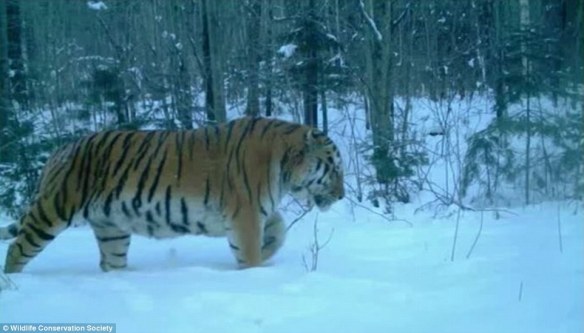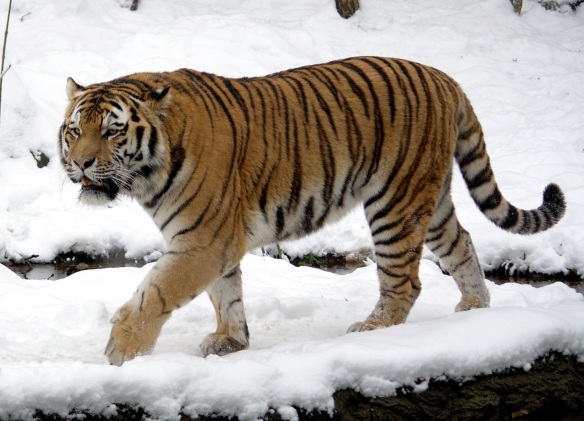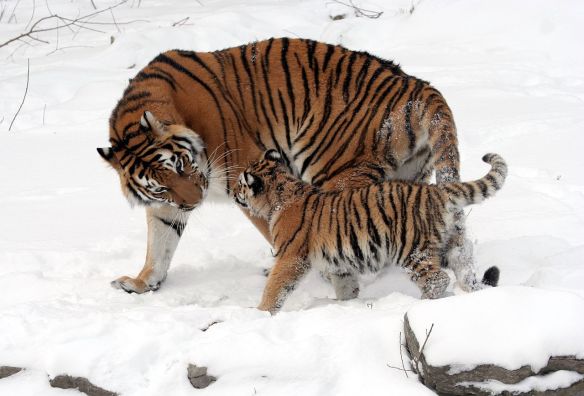The following images captured using camera traps, in Sikhote-Alin Biosphere Reserve in eastern Russia, shows that there is still lots we do not know about the very rare Amur Tiger.

A family of three Amur tiger cubs and a female being led through a snowy forest by a large male. Image created by stitching together several images ©Wildlife Conservation Society
Amur Tigers are known for being solitary and highly secretive cats, sparsely distributed across at least 180,000 km2 in the southern Russian Far East. They are among the most endangered of the big cats, and in 2005 their numbers were estimated between 430-500 individuals remaining in the wild. Surveys are conducted every 10 years (the latest was completed in February and results are to be released this summer) and are highly difficult requiring the involvement of hundreds of scientists, hunters, and volunteers.

Camera traps set up in the forests of Sikhote-Alin Biosphere Reserve in eastern Russia captured these amazing images
– Image Daily Mail Online
It was generally thought that males and females only come to together to mate, the pair separating soon after, but these images which are the first ever recorded, show that on occasion Dad may have a hand in rearing his young.
Slide show of Amur Tiger family walking through the snow
WCS Russia Director Dr. Dale Miquelle said even though there has been “documented sporadic familial groups of Bengal tigers as early as the 1960s, this is the first time such behavior has been photographed for Amur tigers in the wild. These photos provide a small vignette of social interactions of Amur tigers, and provide an evocative snapshot of life in the wild for these magnificent animals.”
21 photos show an entire family of tigers passing in the span of two minutes

Dad leads the way – The first to trigger the camera trap was the large male – Image Daily Mail Online
Luck and timing Deputy Director for Scientific Programs at the Reserve, Svetlana Soutyrina, set these camera traps and says that out of the hundreds of Tiger photographs collected over the years this is the first time they “have recorded a family together…and it confirms that male Amur tigers do participate in family life, at least occasionally” – source Wildlife Conservation Society
Amur Tiger facts
- Panthera tigris altaica is referred to as the Amur or Siberian Tiger
- In the 1940’s populations were estimated to be only 20-30 individuals, widespread hunting for their skins and taking cubs from the wild to supply zoos around the world contributed to their rapid and dangerous decline
- In 1947 Russia outlawed and enforced strict Tiger hunting laws and population recovery happened with established protected areas and maintenance of large tracts of habitat outside of the protected zones
- Research conducted under the Siberian Tiger Project demonstrated that resident female tigers need 250-450 km² to successfully rear cubs where the males territory can be up to 1,385 km² and overlap with several female territories
- Reproduction starts at around 3 years of age, and mating can occur at any time of year with gestation lasting 3 – 3 ½ months
- Tigers often give birth on the ground in dense, brushy areas with most cubs being born in summer and fall
- Litter sizes are between one and five cubs but disease, hunger, congenital defects, and predation claim approximately 50% of cubs in their first year
- Male tigers leave their mothers to find their own territory between 16 and 22 months old traveling hundreds of kilometers in search of a new territory
- In the winter the Siberian Tigers coat can be somewhat lighter than that of other Tigers and people sometimes mistakenly think that they have white fur
- Amur Tigers are classified as Endangered on the IUCN Red List

The Siberian tiger and Bengal tiger subspecies rank among the biggest living cats – Image – Wikipedia
- Poaching of Tiger parts (skin, bones, meat) for use in Traditional Chinese Medicine
- Retaliatory killings of Tigers when the big cats kill livestock and people’s dogs
- Habitat destruction of forest resources by activities such as logging
- Vehicle fatalities by logging trucks and increased poaching due to access roads
- Overhunting by humans of the Tigers prey like elk, wild boar, and sika deer

The oldest Siberian tigers in zoos have lived to 35 years of age, but 14 years is the oldest known age for an Amur tiger in the wild. Image – Wikipedia
Tiger Restoration
Plans to help the Amur Tiger make a comeback include strategies like anti-poaching and snare removal campaigns; education and support for local communities that live with the big cats; and monitoring of Tigers along the Russian-China border.

Protecting this big cat will no doubt require a united and determined effort. Image – Wikipedia
What does the future hold for the recovery of the Amur Tiger? Be sure to check back to read about a groundbreaking experiment underway in Russia that aims to help give these rare animals a much-needed boost.
